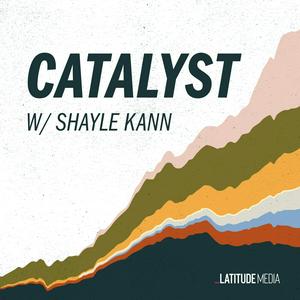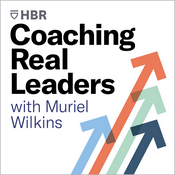Episodios disponibles
5 de 228
- Who benefits from the AI power bottleneck?The bottleneck holding back AI is a scarcity of power, or so goes the story. That may be true — and plenty of reporting backs it up — but different actors in the space face varying incentives to play up or play down that narrative. So what incentives are at play, and how do they shape each player's story? In this episode, Shayle talks to Shanu Mathew, senior vice president and portfolio manager-analyst for U.S, sustainable equity at Lazard. Last month on X, he posted a breakdown of the actors — including hyperscalers, chip makers, utilities, and others – and how the different incentives they face shape how they talk about energy and AI. They cover topics like: Hyperscalers’ mixed incentives: the benefits of building their own capacity vs encouraging others to overbuild Why equipment makers, chipmakers, and land developers benefit from talking up the bottleneck to boost demand for their services How independent power producers and gas players benefit from high prices How the power-bottleneck narrative has shifted over time Resources: Latitude Media: ERCOT’s large load queue has nearly quadrupled in a single year Latitude Media: The power bottleneck is changing data center financing Latitude Media: Early-stage data centers are driving up US power demand forecasts Credits: Hosted by Shayle Kann. Produced and edited by Daniel Woldorff. Original music and engineering by Sean Marquand. Stephen Lacey is our executive editor. Catalyst is brought to you by EnergyHub. EnergyHub helps utilities build next-generation virtual power plants that unlock reliable flexibility at every level of the grid. See how EnergyHub helps unlock the power of flexibility at scale, and deliver more value through cross-DER dispatch with their leading Edge DERMS platform, by visiting energyhub.com. Catalyst is brought to you by Bloom Energy. AI data centers can’t wait years for grid power—and with Bloom Energy’s fuel cells, they don’t have to. Bloom Energy delivers affordable, always-on, ultra-reliable onsite power, built for chipmakers, hyperscalers, and data center leaders looking to power their operations at AI speed. Learn more by visiting BloomEnergy.com. Catalyst is supported by Third Way. Third Way’s new PACE study surveyed over 200 clean energy professionals to pinpoint the non-cost barriers delaying clean energy deployment today and offers practical solutions to help get projects over the finish line. Read Third Way's full report, and learn more about their PACE initiative, at www.thirdway.org/pace.--------34:56
- Looking for a turnaround in transmissionAfter years of stalled transmission buildout, there are new signs of progress. Earlier this month, SPP approved $8.6 billion in transmission projects across 14 states. Major plans are emerging in MISO, PJM, and ERCOT. Despite the DOE canceling its loan guarantee, the Grain Belt Express is still moving forward. And regardless of court battles, so is the New England Clean Energy Connect. Are these signs that the U.S. could start building transmission at scale again? In this episode, Shayle talks to Rob Gramlich, founder and president of Grid Strategies. He and Shayle cover topics like: Why Rob says the DOE’s efforts to fast-track large-load interconnection is a positive sign for transmission buildout The recent buildout of 880 miles of transmission and why it may look better than it is Why transmission hasn’t benefited from data center investment Specific projects, including SPP’s transmission backbone and the Grain Belt Express Rob’s outlook on buildout over the coming year The uncertain future of permitting reform despite bipartisan support Resources: Catalyst: Unpacking DOE’s proposal to transform data center interconnection Latitude Media: How the Grain Belt Express lost its LPO loan E&E News: Data center growth cited in defense of MISO transmission plan Fill out our short podcast listener survey for a chance to win a $100 Amazon gift card. Credits: Hosted by Shayle Kann. Produced and edited by Daniel Woldorff. Original music and engineering by Sean Marquand. Stephen Lacey is our executive editor. Catalyst is brought to you by EnergyHub. EnergyHub helps utilities build next-generation virtual power plants that unlock reliable flexibility at every level of the grid. See how EnergyHub helps unlock the power of flexibility at scale, and deliver more value through cross-DER dispatch with their leading Edge DERMS platform, by visiting energyhub.com.Catalyst is brought to you by Bloom Energy. AI data centers can’t wait years for grid power—and with Bloom Energy’s fuel cells, they don’t have to. Bloom Energy delivers affordable, always-on, ultra-reliable onsite power, built for chipmakers, hyperscalers, and data center leaders looking to power their operations at AI speed. Learn more by visiting BloomEnergy.com.--------29:15
- New Mexico proves America can still build [partner content]Across the country, people are asking the same question: why is it so hard to build in America? From transmission lines to clean energy factories, projects are taking longer, costs are rising, and frustration is growing. But in New Mexico, two cabinet secretaries are trying to show that it doesn’t have to be this way. Together, Economic Development Secretary Rob Black and Environment Secretary Jim Kenney are helping redefine how state agencies work with industry. Their model blends speed, access, and careful environmental oversight to help companies build more quickly without cutting corners. Together, they’re using that model to attract billion-dollar fusion and geothermal projects, expand water and infrastructure investments, and deploy the state’s $65 billion sovereign wealth fund directly into advanced energy and deep-tech manufacturing. In this episode, Stephen Lacey talks with Rob Black and Jim Kenney about how New Mexico is rewriting the rules of economic development, and what their partnership can teach the rest of America about how to make government work again. This is a partner episode, produced in collaboration with the New Mexico Economic Development Department, which works to expand opportunity through innovation, infrastructure, and investment across the state.--------31:15
- Driving down the cost of green hydrogenA few years ago, industry and political leaders embraced hydrogen as a solution to a laundry list of hard-to-abate decarbonization challenges — steel production, ammonia production, and more. But hydrogen failed to come down in costs and policymakers pulled back support. Ultimately, the bubble burst. So what does it take to drive down the costs of low-carbon hydrogen and rebuild momentum? In this episode, Shayle talks to Raffi Garabedian, co-founder and CEO of Electric Hydrogen. (Shayle is on the board of Electric Hydrogen and Energy Impact Partners, where Shayle is a partner, invests in the company). Shayle and Raffi cover topics like: Why the hype bubble burst: political pullback, high renewables costs driven by AI demand, and high CapEx The real cost problem: Why engineering, procurement, and construction (EPC) costs have remained persistently high Competing approaches: Why Electric Hydrogen chose supersized electrolyzers over modular units The China question: Why hydrogen’s EPC costs will limit the impact of cheap Chinese electrolyzers Real numbers: Realistic cost targets for fossil parity and Electric Hydrogen’s current pricing Where hydrogen wins: Markets where Raffi says green hydrogen can achieve fossil parity by the early 2030s, including Brazilian fertilizer Resources: Latitude Media: is 45v guidance killing green hydrogen production? The Green Blueprint: Electric Hydrogen’s bet on supersized electrolyzers Latitude Media: Electric Hydrogen is building through the market downturn Latitude Media: Hydrogen’s narrow pathway to positive climate impacts Latitude Media: Why the Electric Hydrogen-Ambient merger is a sign of things to come Fill out our short podcast listener survey for a chance to win a $100 Amazon gift card. Credits: Hosted by Shayle Kann. Produced and edited by Daniel Woldorff. Original music and engineering by Sean Marquand. Stephen Lacey is our executive editor. Catalyst is brought to you by EnergyHub. EnergyHub helps utilities build next-generation virtual power plants that unlock reliable flexibility at every level of the grid. See how EnergyHub helps unlock the power of flexibility at scale, and deliver more value through cross-DER dispatch with their leading Edge DERMS platform, by visiting energyhub.com. Catalyst is brought to you by Bloom Energy. AI data centers can’t wait years for grid power—and with Bloom Energy’s fuel cells, they don’t have to. Bloom Energy delivers affordable, always-on, ultra-reliable onsite power, built for chipmakers, hyperscalers, and data center leaders looking to power their operations at AI speed. Learn more by visiting BloomEnergy.com. Catalyst is supported by Third Way. Third Way’s new PACE study surveyed over 200 clean energy professionals to pinpoint the non-cost barriers delaying clean energy deployment today and offers practical solutions to help get projects over the finish line. Read Third Way's full report, and learn more about their PACE initiative, at www.thirdway.org/pace.--------41:28
- Inside a $300 million bet on AI for physical R&DA big problem with using artificial intelligence to discover new materials? It struggles to predict beyond its training data. That means AI might be better at optimizing known materials than discovering entirely new ones — like a room temperature superconductor or carbon-capture sorbents. But since we last covered the topic in September 2024, a few things have changed. OpenAI released its powerful O1 reasoning model. Large language models have also gotten better at math, physics, and coding. And lab automation — robots mixing liquids and powders, running characterization tests — has improved, allowing for a higher volume of experiments. So, can these improvements overcome AI’s training data problem? In this episode, Shayle talks to Ekin Dogus Cubuk, cofounder of Periodic Labs, which raised $300 million seed round in September. Last year, Dogus took a more cautious view on using AI for materials discovery. Now though, he’s convinced there’s a clearer path forward for physical science research and development, especially materials discovery. Shayle and Dogus cover topics like: Creating experimental and synthetic data to overcome AI’s limitations of predicting beyond its training set Why we should focus on breakthrough discoveries over easier, incremental wins The different roles humans and AI play in the discovery process Period’s focus on automated experimental labs using AI-generated hypotheses Resources: Catalyst: Can AI revolutionize materials discovery? Latitude Media: This ‘superintelligence platform’ just raised $200m in seed funding Latitude Media: Can AI get us closer to fusion? The New York Times: Top A.I. Researchers Leave OpenAI, Google and Meta for New Start-Up Credits: Hosted by Shayle Kann. Produced and edited by Daniel Woldorff. Original music and engineering by Sean Marquand. Stephen Lacey is our executive editor. Catalyst is brought to you by EnergyHub. EnergyHub helps utilities build next-generation virtual power plants that unlock reliable flexibility at every level of the grid. See how EnergyHub helps unlock the power of flexibility at scale, and deliver more value through cross-DER dispatch with their leading Edge DERMS platform, by visiting energyhub.com. Catalyst is brought to you by Bloom Energy. AI data centers can’t wait years for grid power—and with Bloom Energy’s fuel cells, they don’t have to. Bloom Energy delivers affordable, always-on, ultra-reliable onsite power, built for chipmakers, hyperscalers, and data center leaders looking to power their operations at AI speed. Learn more by visiting BloomEnergy.com. Catalyst is supported by Third Way. Third Way’s new PACE study surveyed over 200 clean energy professionals to pinpoint the non-cost barriers delaying clean energy deployment today and offers practical solutions to help get projects over the finish line. Read Third Way's full report, and learn more about their PACE initiative, at www.thirdway.org/pace.--------36:26
Más podcasts de Economía y empresa
Podcasts a la moda de Economía y empresa
Acerca de Catalyst with Shayle Kann
Investor Shayle Kann is asking big questions about how to decarbonize the planet: How cheap can clean energy get? Will artificial intelligence speed up climate solutions? Where is the smart money going into climate technologies? Every week on Catalyst, Shayle explains the world of climate tech with prominent experts, investors, researchers, and executives. Produced by Latitude Media.
Sitio web del podcastEscucha Catalyst with Shayle Kann, Chisme Corporativo y muchos más podcasts de todo el mundo con la aplicación de radio.net

Descarga la app gratuita: radio.net
- Añadir radios y podcasts a favoritos
- Transmisión por Wi-Fi y Bluetooth
- Carplay & Android Auto compatible
- Muchas otras funciones de la app
Descarga la app gratuita: radio.net
- Añadir radios y podcasts a favoritos
- Transmisión por Wi-Fi y Bluetooth
- Carplay & Android Auto compatible
- Muchas otras funciones de la app


Catalyst with Shayle Kann
Escanea el código,
Descarga la app,
Escucha.
Descarga la app,
Escucha.






































